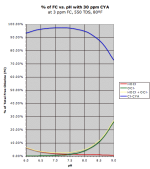- Jun 22, 2014
- 51,637
- Pool Size
- 17888
- Surface
- Fiberglass
- Chlorine
- Salt Water Generator
- SWG Type
- CircuPool RJ-45 Plus
If the ripples are strong enough to cause an aeration effect - yes. It has be fairly strong to do that. If you just see very small, tiny ripples or waves, probably not so much. PH tends to be a pain more in the summer, but the most common reasons for a rising pH are:does the movement of water from the return jets during the pump run I can see it moving the surface water going to effect the PH rise?
- Elevated TA (say 60 or higher)
- Aeration
- New plaster
- Someone added a chemical to make it rise


